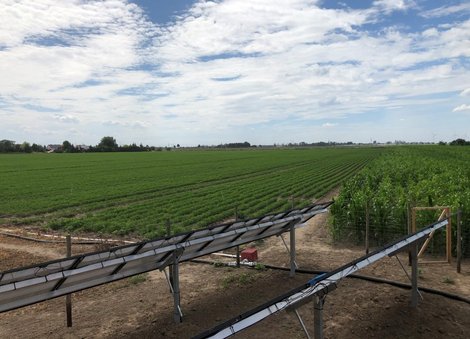Increasing Crop Yield While Using Less Water

Smart farming is one answer to the question of how to deal with challenges of the future. The IrriMode project in Saxony-Anhalt has taken this approach on board and is working toward self-sufficient agriculture that can endure climate change. Initial tests have been very promising.
Smart farming is also known as digital farming or e-farming, and is often referred to as “Agriculture 4.0” and “Farm 4.0” in Germany. But its name is of secondary importance – what really matters is its objective. It aims to respond to overpopulation, the global hunger that inevitably comes with it and, most importantly, climate change. The use of modern information and communication technology in agriculture can help farmers increase crop yields and to reduce their use of resources at the same time.
Saxony-Anhalt is taking this challenge very seriously. That’s why the IrriMode project was founded in 2017 by an operating group consisting of three partners: the firm AGRO-SAT from Baasdorf, Gut Mennewitz GmbH and engineering company Irriproject Dirk Borsdorff from Potsdam. DLG e.V., Anhalt University of Applied Sciences and DHI WASY GmbH are associated partners. “Our work is focused on optimizing a real-time, fully automated, solar-powered irrigation process,” explains Antje Augstein from AGRO-SAT. “We are using a soil water preservation model and a crop growth model.” The former takes into account soil quality, the water retaining capacity in the area penetrated by roots (root development depth) and the climate conditions in the region. In the second model, crop type, size and root depth and the leaf area index play a role.
Calculating water quantity
The data collected from the two models are processed and displayed in graphs. A special software developed by the partner DHI WASY uses a real-time process model to calculate whether it is necessary to irrigate the crops. If it is, signals are sent to the irrigation, solar and pump control system, which then opens the controllable valves and irrigates the testing area. To enable this, drip tubes are laid at regular intervals and are connected in groups to the water distribution system, which was planned on a computer beforehand by engineering company Irriproject. The energy needed for the irrigation control system is generated from solar power created using solar modules. A solar pump distributes the necessary water quantity from the reservoir to the fields via low-pressure piping. The data for the virtual evaluation are gathered by ground sensors (provided by AGRO-SAT) and a weather station. Put simply, if the ground is wet, it isn’t irrigated. If it is dry, water is supplied fully automatically by the highly water-efficient system, which irrigates the ground right where the crop roots are as water trickles slowly from the outlets in the drip tubes.
Two sites
The project is operating two testing sites. At first, two hectares of land was put into operation on a testing ground belonging to the Internationales DLG-Pflanzenbauzentrum (International DLG Crop Cultivation Center) in Bernburg-Strenzfeld. Soya and wheat are grown here in alternation on a total of 16 plots of land, half of which are irrigated in the conventional way and the other half using smart irrigation systems with tubes laid 40 cm in the ground.
The second site is in Arensdorf and belongs to Gut Mennewitz GmbH. This site uses overground irrigation along the planted embankments with the help of solar modules, a fountain, a water container and simulation models. Information gathered by the ground sensors and the weather station is also integrated into the calculations. Tests were carried out on a crop of carrots, one part of which was irrigated conventionally and the other using the smart process. They were planted in May and harvested in November. “The yield was excellent,” says Augstein. “The carrots that were irrigated automatically were larger than the others.”
Systems will pay off
The project will continue until around September 2022. It is already clear that fully automated irrigation, which can be used for all types of fruit and vegetable cultivation, is successful. Although the financial costs are admittedly high, Antje Augstein is certain that it will ultimately pay off: “Climate change will require us to control our use of water more strictly. The higher the price of water, the more this type of system will be worth it.” What’s more, solar power is free, meaning you can recoup the cost of the modules within a few years. That is especially true given substances such as liquid fertilizer could be spread in a targeted way using this method – which may well be the next step in the testing.
The high costs are one of the reasons why this type of digital farming is not yet widely used. Augstein is therefore grateful for the support from the state of Saxony-Anhalt, which is actively assisting the project. While the funds are being provided by the EU, the Ministry of the Economy is on hand to help establish contacts with innovative service providers for EIP-Agri and consultation. The IrriMode project is also benefiting from the Anhalt University of Applied Sciences, which has taken on the role of monitoring the test fields in Strenzfeld and Arensdorf and is carrying out scientific evaluations and studies.
Once the project is over, various agricultural and gardening models could be created. “We could process these models on an internet platform and give farmers the opportunity to store their data there. We would be responsible for maintenance and delivering and fitting the ground sensors,” says Augstein. The success of drip irrigation in its own right has been demonstrated in Israel since the 1930s, and more recently in other countries who also have drought problems. Despite poor soil and scarce resources, these countries have managed to produce sufficient crop yields. Dirk Borsdorff, one of the IrriMode partners, spent some time in Israel studying the system. When he returned, he founded the IrriMode project.
Anja Falgowski/IMG Saxony-Anhalt

Find out more HERE: > Food industry in Saxony-Anhalt
